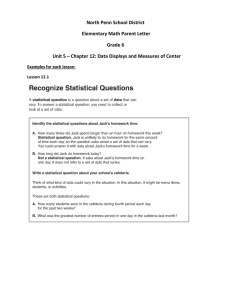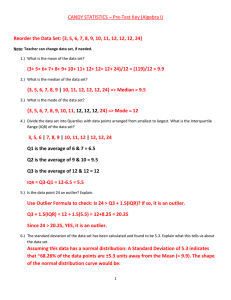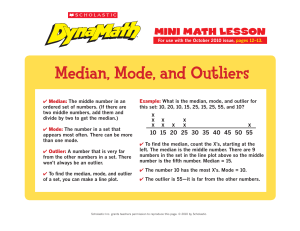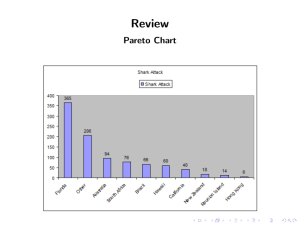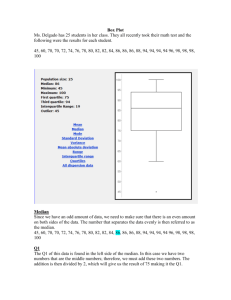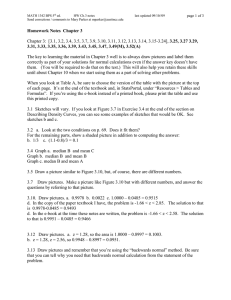MATH 1342 BPS 5
advertisement
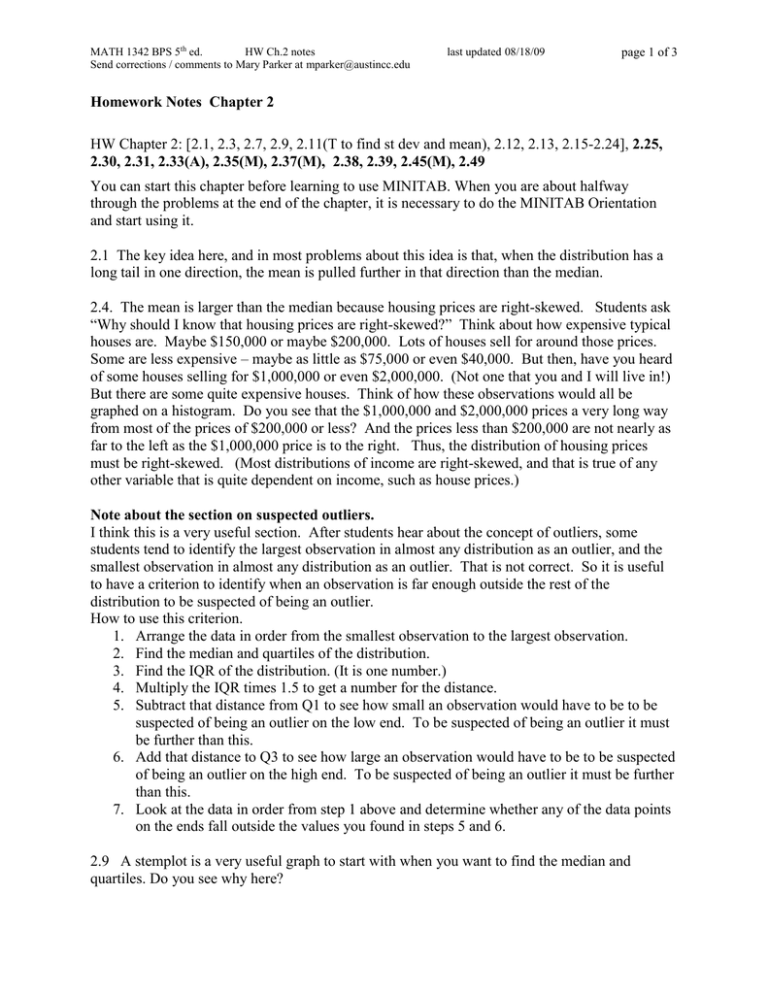
MATH 1342 BPS 5th ed. HW Ch.2 notes Send corrections / comments to Mary Parker at mparker@austincc.edu last updated 08/18/09 page 1 of 3 Homework Notes Chapter 2 HW Chapter 2: [2.1, 2.3, 2.7, 2.9, 2.11(T to find st dev and mean), 2.12, 2.13, 2.15-2.24], 2.25, 2.30, 2.31, 2.33(A), 2.35(M), 2.37(M), 2.38, 2.39, 2.45(M), 2.49 You can start this chapter before learning to use MINITAB. When you are about halfway through the problems at the end of the chapter, it is necessary to do the MINITAB Orientation and start using it. 2.1 The key idea here, and in most problems about this idea is that, when the distribution has a long tail in one direction, the mean is pulled further in that direction than the median. 2.4. The mean is larger than the median because housing prices are right-skewed. Students ask “Why should I know that housing prices are right-skewed?” Think about how expensive typical houses are. Maybe $150,000 or maybe $200,000. Lots of houses sell for around those prices. Some are less expensive – maybe as little as $75,000 or even $40,000. But then, have you heard of some houses selling for $1,000,000 or even $2,000,000. (Not one that you and I will live in!) But there are some quite expensive houses. Think of how these observations would all be graphed on a histogram. Do you see that the $1,000,000 and $2,000,000 prices a very long way from most of the prices of $200,000 or less? And the prices less than $200,000 are not nearly as far to the left as the $1,000,000 price is to the right. Thus, the distribution of housing prices must be right-skewed. (Most distributions of income are right-skewed, and that is true of any other variable that is quite dependent on income, such as house prices.) Note about the section on suspected outliers. I think this is a very useful section. After students hear about the concept of outliers, some students tend to identify the largest observation in almost any distribution as an outlier, and the smallest observation in almost any distribution as an outlier. That is not correct. So it is useful to have a criterion to identify when an observation is far enough outside the rest of the distribution to be suspected of being an outlier. How to use this criterion. 1. Arrange the data in order from the smallest observation to the largest observation. 2. Find the median and quartiles of the distribution. 3. Find the IQR of the distribution. (It is one number.) 4. Multiply the IQR times 1.5 to get a number for the distance. 5. Subtract that distance from Q1 to see how small an observation would have to be to be suspected of being an outlier on the low end. To be suspected of being an outlier it must be further than this. 6. Add that distance to Q3 to see how large an observation would have to be to be suspected of being an outlier on the high end. To be suspected of being an outlier it must be further than this. 7. Look at the data in order from step 1 above and determine whether any of the data points on the ends fall outside the values you found in steps 5 and 6. 2.9 A stemplot is a very useful graph to start with when you want to find the median and quartiles. Do you see why here? MATH 1342 BPS 5th ed. HW Ch.2 notes Send corrections / comments to Mary Parker at mparker@austincc.edu last updated 08/18/09 page 2 of 3 2.11 How to do this: Ask your instructor how you are expected to compute standard deviations – with a calculator or with computer software. Also ask your instructor if there are any restrictions on the type of calculator you can use on a test. Skip this problem if you haven’t yet learned to use your calculator or the software you will use. Come back to it after that. What do you notice? It is very important that you notice here that just knowing the mean and standard deviation of a dataset does not give you all the interesting information about it. Those do not tell you anything about the shape. A graph (histogram or stemplot) tells you the shape. 2.12 Sometimes students think “I am asked for a numerical summary, so I’ll just compute every statistic I know how to compute and tell them all. Surely that will earn full credit.” But it won’t. The point is not to show that you can compute them all, but to understand what each one is telling you and NOT telling you. That leads to understanding which ones are most appropriate in various situations. Pay careful attention to this problem. Discuss your ideas with other students. 2.13 Be sure to identify the four steps and write words for each one as well as the appropriate calculations and summaries. Because the datasets are quite small in 2.13, it is easier to do this problem by hand than with software. The software packages don’t make side-by-side stemplots as shown in the example – you’ll need to write those by hand and line them up appropriately. And probably you don’t really want to compute the standard deviations by hand. So understand the basic ideas here by doing everything except the standard deviations by hand. We’ll get to the software soon. 2.25. See the comments for Exercise 2.4. 2.27. Notice that this only asks for the position of the median and quartiles, not their actual values. Be sure that you make the distinction between the position and the actual values and notice which is asked for in any particular problem. 2.30. I don’t think it is necessary for you to actually list all 74 scores in the distribution, but you should be able to do that just from this histogram. If you start doing that, I think you’ll see how to do it. And then you can probably answer this question. 2.31. The numbers are big here, but this is a problem to do by hand, with a calculator. 2.33. This applet problem gives you a way to conduct a very useful experiment which can help you develop and reinforce your intuition about the behavior of the median and the mean. Write your observations and conclusions carefully and discuss them with other students. MANY OF THE FOLLOWING PROBLEMS REQUIRE YOU TO USE SOFTWARE. If you haven’t yet started on the software, skip those problems for now and come back to them after you have done the software orientation. 2.35. Use software. This problem requires you to choose an appropriate type of graph and numerical summary, then use software to make those, and then interpret them. What types of graphs did we learn that show the shape of a distribution? (Ch. 1) How do you choose an MATH 1342 BPS 5th ed. HW Ch.2 notes Send corrections / comments to Mary Parker at mparker@austincc.edu last updated 08/18/09 page 3 of 3 appropriate numerical summary? (p. 52.) It isn’t correct to simply give all possible graphs and numerical summaries. That indicates that you don’t know how to choose them. 2.37. Use software. Don’t even think about typing in the 51 values into anything. That is a waste of time. Practice using software here. Use your time and energy on the interpretation, not the calculations. 2.38-2.42 These are “thought” questions. Think about them and discuss them with others as needed. The point is not the numerical answers, but the insight you’ll gain about what the standard deviation, mean, and median. 2.45. Use software. If you need more practice on problems like this, practice with one of the next three problems as well. 2.49. This is an important problem. If you need more practice using this concept, practice with one of the next three problems as well.
